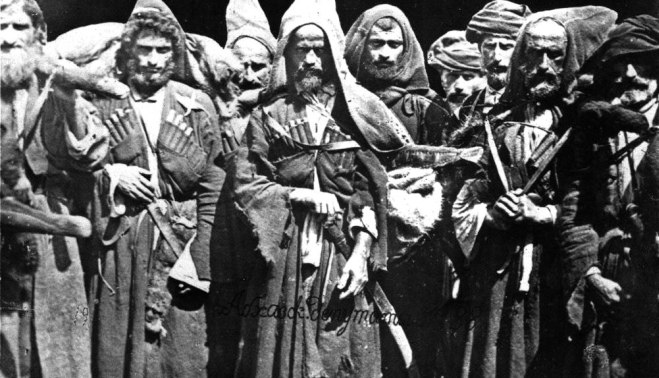
Thirty years of "guilt" (1877-1907), by Stanislav Lakoba
Immediately after the Caucasian War (21 May 1864), in June 1864 the independent princedom of Abkhazia was abolished, and the sovereign prince Mikhail Shervashidze (Chachba) was subjected to political repression; in 1866, he died in exile in Voronezh.
The abolition of Abkhazian statehood, the renaming of Abkhazia as the "Sukhum Department" under a "military-national government", the introduction of direct imperial administration and the death of the last ruler of Abkhazia, all this caused great dissatisfaction among the people and led to the Lykhny (Abkhazian) Uprising in 1866 and the massive forced resettlement (Makhadzhirstvo) of the Abkhazians to Turkey in 1867.
In 1877, there broke out in Abkhazia a new insurrection. Similar uprisings occurred at that time in Daghestan and the Terek Region; they were closely related to the events of the Russo-Turkish war of 1877-1878. In early May 1877, the Turkish fleet bombarded the coast of Abkhazia and landed a contingent of troops in Sukhum which consisted mainly of Abkhazian Makhadzhirs.
The Head of the Sukhum Department, General Kravchenko, on the eve of this attack, ordered the abandonment of the city, thereby depriving the population of central Abkhazia of necessary defence. The behaviour of the General pushed the Abkhazians to come out on the side of Turkey. A monk-chronicler from New Athos wrote as follows: "Kravchenko not only made no preparations to defend the city but even withdrew his troops from it." Immediately after the surrender of Sukhum, General Kravchenko was recalled to Tbilisi. In Abkhazia, only the Samurzakan (now the Gal) District) remained under the protection of Russian arms.
As a result of military operations, up to 50,000 Abkhazians were forced in 1877 to abandon their homeland and relocate to Turkey. The new head of the Sukhum Department, Colonel Arakin, reported on 24 August 1878: "The area that lies between the River Galidzga and the River Kodor is already shewing significant traces of devastation: the area around Ochamchira is razed to the ground ... The expanse from the R. Kodor all the way to the Gudauta area, together with Tsebelda, is almost a perfect desert. " Sukhum and Gudauta were torched and ruined.
Colonel Arakin proposed to declare the entire Abkhazian population "guilty", because "to determine the degree of involvement in the mutiny of each community and of individual persons through an investigation would require too much time." As an advocate of measures "of a punitive character", he thought it necessary to "group together" the Abkhazian population, thus violating the traditional farmstead-character of the way that the Abkhazian peasantry had settled on the land. Fortunately, this point was not implemented.
Abkhazians were forbidden to carry arms, to settle near the coast (except for the upper classes), or live in Sukhum, Gudauta, Ochamchira. The devastated central part of Abkhazia between the rivers Psyrtskha and Kodor became a colonised land-fund of the imperial administration. There was established here a kind of buffer-zone between the Gudauta and Ochamchira Abkhazians. Abkhazians had no right to settle in this part of their own country. Meanwhile, thousands of Armenians, Mingrelians, Greeks, Russians, Estonians, Germans, Moldovans and others who were resettled began from 1879 to take root here in today's Sukhum and Gulripsh districts. Thus, in the aftermath of the Russo-Turkish war of 1877-1878 and the huge outward flow of the Makhadzhirstvo [Great Exile], the ethnic situation in Abkhazia changes dramatically: from being homogeneous, basically mono-ethnic in its composition, it turns into a cosmopolitan region.












